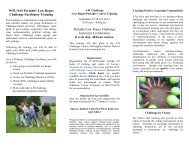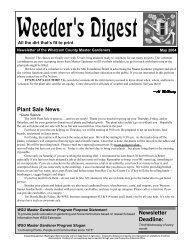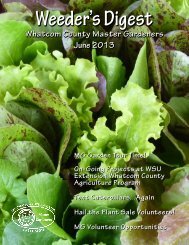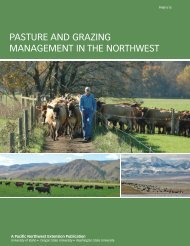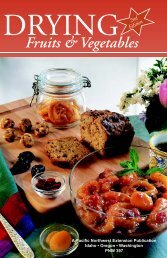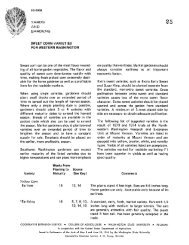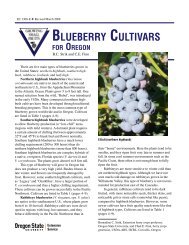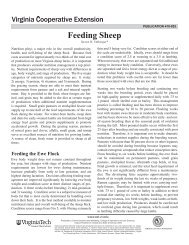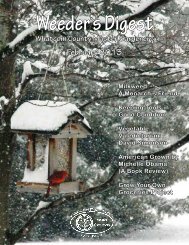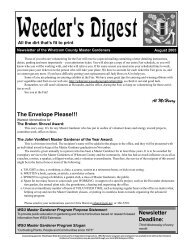Where Does Whatcom County Get its Food? - WSU Whatcom ...
Where Does Whatcom County Get its Food? - WSU Whatcom ...
Where Does Whatcom County Get its Food? - WSU Whatcom ...
You also want an ePaper? Increase the reach of your titles
YUMPU automatically turns print PDFs into web optimized ePapers that Google loves.
A deeper look into WWU food service<br />
Seth Vidaña from WWU Office of Sustainability gave some insight into the food service program at WWU.<br />
Historically, WWU has used very little local food. In the past 3 years, the food service provider, Sodexho, has<br />
increased <strong>its</strong> local food (defined as within 150 miles) purchases to 5.5% of the total amount. Most of this comes as<br />
liquid milk (from Edaleen Dairy) and apples (from Bellewood Acres), with additional products coming from other<br />
farms in Washington State. Vertical integration of supply chains encourages Sodexho’s institutional customers to<br />
purchase their food from the Sodexho distributor. However, the company’s service at WWU receives high marks<br />
from WWU students and staff within Sodhexo’s corporate evaluation system for efforts to purchase local food.<br />
Sodhexo is also doing a lot to reduce their waste products, including the introduction of a “trayless” dining hall<br />
program, which has reduced food waste generated by diners by 30%, and working with Sanitary Service<br />
Corporation (SSC)’s <strong>Food</strong>Plus! recycling program to have food waste collected from kitchens, dining halls, and<br />
Birnham Wood residences. The result of these initiatives is that approximately 140,000 pounds of food waste per<br />
year avoids the landfill. x<br />
Other food-related activities at WWU<br />
Students have organized a couple of groups on campus looking into sustainable food systems. The “Students for<br />
Sustainable <strong>Food</strong>” group is interested in bringing more locally grown organic food into the food service at WWU,<br />
and the “Student Co-op” group is pursuing a student-run dining hall. There is interest in creating a farmers market<br />
or Community Supported Agriculture program on campus for students and staff to purchase locally grown food to<br />
prepare at home. WWU also has the Outback Farm, an area of campus where students have a community garden<br />
for producing their own food; other areas are designated for student projects, such as the forest garden and<br />
edible weed garden projects.<br />
The Emergency <strong>Food</strong> System<br />
Poverty is a major factor in the access to food. With 14.7% of <strong>Whatcom</strong> <strong>County</strong> residents below federal poverty<br />
guidelines, the emergency food system is an important institution for feeding the community. xi It consists of many<br />
organizations helping to provide food for those in need.<br />
Although not all emergency food providers maintain exact records of clients served and the growing need in<br />
<strong>Whatcom</strong> <strong>County</strong>, several of the larger organizations do. The number of client vis<strong>its</strong> to the Bellingham <strong>Food</strong> Bank<br />
since 2007 has risen by 39%. Other service providers agreed that they had experienced similar increases.<br />
Programs outlined below are divided into two sections: emergency food providers, such as food banks, and<br />
organizations that grow food for emergency food programs and providers. All information is from personal<br />
communication with directors or key employees/volunteers of the emergency food programs.<br />
<strong>Food</strong> Banks and Emergency <strong>Food</strong> Providers<br />
Bellingham <strong>Food</strong> Bank is the largest emergency food provider in <strong>Whatcom</strong> <strong>County</strong>. Each year the Bellingham <strong>Food</strong><br />
Bank receives over 100,000 client vis<strong>its</strong> and distributes more than 2 million pounds of food to low-income<br />
individuals and families; 35% of clients are children and 16% are seniors. The Bellingham <strong>Food</strong> Bank also serves as<br />
the redistribution center for 9 other <strong>Whatcom</strong> <strong>County</strong> food banks and receives USDA commodity food and other<br />
bulk food on behalf of the <strong>County</strong> food bank system.<br />
Bellingham <strong>Food</strong> Bank works with grocers, bakeries, fisheries and other food producers and retailers to recover<br />
any of their edible waste for redirection to <strong>its</strong> distribution stream.<br />
Working with Growing Washington, the Bellingham <strong>Food</strong> Bank manages the Small Potatoes Gleaning Project, the<br />
<strong>Food</strong> Bank Farm, and the Farm to <strong>Food</strong> Bank project (see next section: <strong>Food</strong> Being Grown for Emergency <strong>Food</strong><br />
Programs).<br />
29



